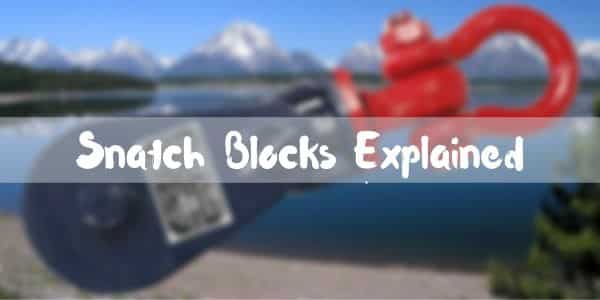Last Updated on August 11, 2022
A snatch block is a user-friendly piece of machinery with simple build quality. If you are an off-roader, then you must have heard about it already. But if you didn’t then it is high time you get one of those for yourself. It plays a supporting yet vital role alongside your winch and can pull you out from many tricky situations.
So if you have a car and you love to go off-roading or even for a long drive adding a snatch block in your gearbox is a no brainer. Now after buying it you should also know how to use it. That’s what I am here to discuss today. Now first things first.
You may also like to read our guide on Double winch pulling power, kinetic recovery rope and using recovery straps.
Quick Navigation
What is a Snatch Block?
A snatch block is simply one kind of pulley block. So, you can easily guess that it is used for pulling jobs. It has a side plate that swings open to put the winch cable over the pulley. It saves you the hassle of trying to thread your winch cable through the opening. It has mainly two jobs.
First, it helps in changing the direction of the cable when you have an offset anchor point. Second, it increases the pulling power of your winch by almost 2 times.
Snatch Block Types
Depending on design, size and uses, many different categories of snatch block exist. We can say that there are 3 types of snatch blocks based on the design and mechanism.
Those are snatch block with hook, snatch block with shackle and swing block. For recovering vehicles, the swing block is the most commonly used snatch block among these three types.
How to Use a Snatch Block?
You can use a snatch block for two types of winch rigging. One is for an offset anchor point and another one is for double line pull. I will discuss both of them briefly.
Offset anchor point
One of the basic rules for winching is to make sure that the cable rolls up on the winch drum evenly. This is always the case when you are winching in a straightforward position. However, sometimes you can face the problem of pulling at an angle. This situation can create the problem of gathering most of the cable on any one side of the winch drum.
For a straightforward anchor point winching is easy. When you don’t have that privilege, you can use the snatch block for an angled single line pull. For that, you have to run the cable through the snatch block to an offset anchor point. Then you have to find another offset anchor point in the opposite direction as the first anchor point. You should use a choke chain to attach the snatch block to the second anchor point.
At last, use the tension the two offset anchor point creates to position the block in front of the vehicle in a direct way. Here the snatch block diverts the cable at a proper angle to reach the offset anchor point.
Double Line Pull
The double line pull generates double pulling power for your winch. However, it also cuts the pulling speed and makes it slow. This one is for the situation where you will need to pull a vehicle heavier than the winch can pull or is bigger than your vehicle. A double line pull requires using the snatch block to divert the cable back towards the winch.
If you are pulling your own vehicle, then you have to run the cable through the snatch block and then bring it back to your own vehicle. The snatch block should be attached to a distant anchor point which should be positioned directly in front of your vehicle.
However, if you are pulling another vehicle, then the snatch block must be attached to the stuck vehicle. The cable goes through the snatch block and back to an anchor point that’s close to your vehicle. The anchor point takes some tension off your vehicle.
Though the double line pull provides slow pulling speed, it is totally worth it for the extra power it generates. Always keep in mind that everything has a maximum capacity including your snatch blocks and winch. Make sure you are not putting too much pressure on your machine.
Snatch Block Safety
If snatch block isn’t handled properly, then it can cause serious accidents.
A massive amount of pressure passes through the snatch block when you use the snatch block in conjunction with a winch. The pressure on the line can get as much as twice the actual load that you’re trying to pull. If too much pressure builds up on one side and the snatch block fails, then this could do serious damage.
You must attach all the components securely and set up the equipment properly. Also, if you don’t secure the anchor point or it becomes fails to handle the pressure, then this could result in disaster too.
When using a snatch block, remember to use a line dampener. You could avoid accidents if you follow all the safety rules while using a snatch block
I have also reviewed some necessary offroad gears including winch battery, off road air compressor, offroad battery etc. You can read this if you ever plan to buy any of these.


I’m Daniel Galbreath, founder of OffRoadersWorld.
I spend my spare time writing on this website, OffRoaders World. I share my thoughts and reviews on different types of gears, share tips sometimes. This website is specially created and regularly updated basically to help other folks like me when I started to solve the various problems they face, specially when they go off-roading.

Good article.
Thanks
A diagram would be helpful to understand this.
You may find this post helpful which includes a video and diagram